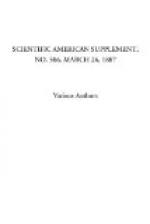The only improvement we could suggest in the arrangement is that all the prints should have been from the same negative, or from only three negatives, so that we should have prints from the same negatives in every group, and should the better be able to compare the results of the toning baths. Probably, however, the indifferent light of the present season of the year made it difficult to get a sufficiency of prints from one negative.
The following is a description of the toning baths used and of the appearance of the prints. We refer, in the mean time, only to those halves that have not been treated with bichloride of mercury.
1.--Gold chloride (AuCl_{3})........... 1 gr.
Sulphocyanide of potassium......... 10 gr.
Hyposulphite of soda............... 1/2 gr.
Water.............................. 2 oz.
The prints are of a brilliant purple or violet color.
2.--Gold chloride...................... 1 gr. Sulphocyanide of potassium......... 10 gr. Hyposulphite of soda............... 1/2 gr. Water.............................. 4 oz.
There is only one print, which is of a brown color, and in every way inferior to those toned with the first bath.
3.--Gold chloride...................... 1 gr. Sulphocyanide of potassium......... 12 gr. Hyposulphite of soda............... 1/2 gr. Water.............................. 2 oz.
The prints toned by this bath are, in our opinion, the finest of the whole. The tone is a purple of the most brilliant and pleasing shade.
4.--Gold chloride...................... 1 gr. Sulphocyanide of potassium......... 20 gr. Hyposulphite of soda............... 5 gr. Water.............................. 2 oz.
There is only one print, but it is from the same negative as one of the No. 3 group. It is very inferior to that in No. 3, the color less pleasant, and the appearance generally as if the details of the lights had been bleached by the large quantity either of hypo or of sulphocyanide of potassium.
5.--Gold chloride...................... 1 gr. Sulphocyanide of potassium......... 50 gr. Hyposulphite of soda............... 1/2 gr. Water.............................. 2 oz.
Opposite to this description of formula there are no prints, but the following is written: “These prints were completely destroyed, the sulphocyanide of potassium (probably) dissolving off the gelatine.”
6.--Gold chloride...................... 1 gr. Sulphocyanide of potassium......... 20 gr. Hypo............................... 5 gr. Carbonate of soda.................. 10 gr. Water.............................. 2 oz.
This it will be seen is the same as 4, but that the solution is rendered alkaline with carbonate of soda. The result of the alkalinity certainly appears to be good, the color is more pleasing than that produced by No. 4, and there is less appearance of bleaching. It must be borne in mind in this connection that the paper itself is strongly acid, and that, unless special means be taken to prevent it, the toning bath is sure to be more or less acid.




